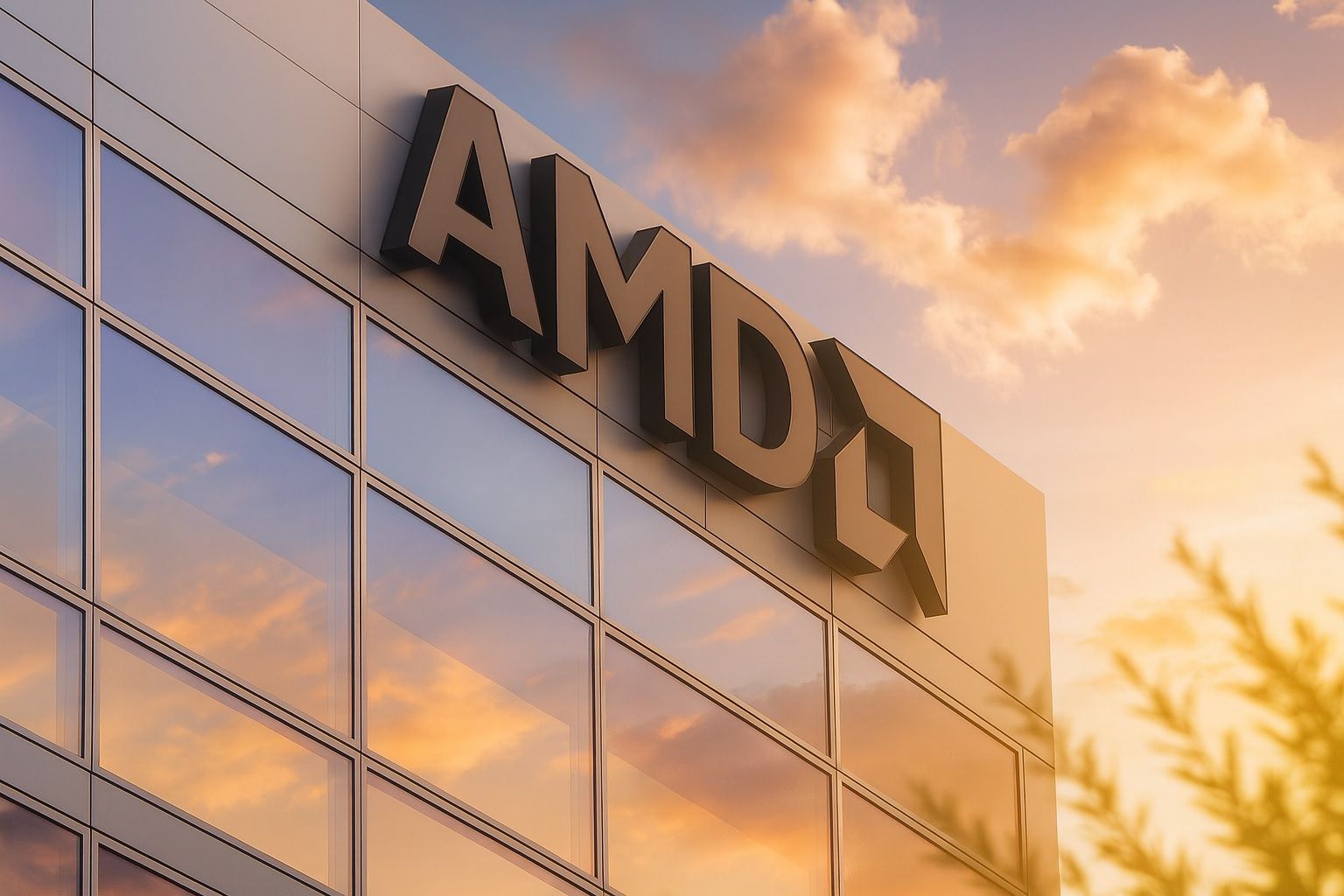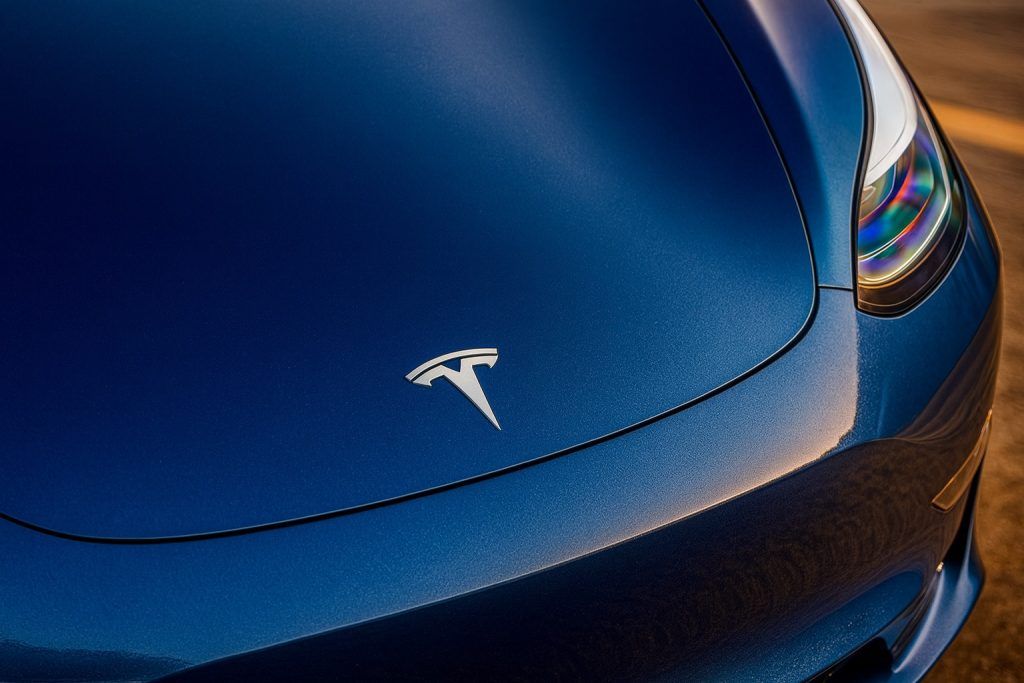- Current Price (Oct 31, 2025): ~$256.12 per share (close) [1], up ~0.5% that day and roughly +80% year-to-date [2].
- Recent Moves: The stock exploded in October on AI-related news – touching a 52-week high near $240 on Oct. 15 [3] and peaking around $264 by Oct. 29 [4], before a modest pullback into month’s end.
- AI Deals: Two blockbuster partnerships have driven the rally. AMD agreed on Oct. 6 to supply OpenAI with roughly 6 gigawatts of its Instinct AI GPUs (with warrants for ~10% of AMD stock) [5] [6]. Then on Oct. 14, Oracle announced it will deploy 50,000 of AMD’s forthcoming MI450 GPUs in its cloud “AI superclusters” starting in late 2026 [7] [8].
- Analyst Sentiment: Wall Street has turned very bullish. Major firms (Jefferies, Wolfe, HSBC) have raised 12-month targets to ~$300 [9], and about 60–65% of analysts now rate AMD a “Buy” [10]. For example, Susquehanna’s Christopher Rolland raised his target to $300 (Buy) on Oct. 31 [11]. (By contrast, the average 12-month target is ~$250 [12], implying limited upside from current levels.)
- Compared to Peers: AMD has far outpaced Intel and rivals but still trails NVIDIA. In 2025 AMD is up roughly +80% [13] (versus ~+30–40% for Nvidia and little change for Intel) [14]. Nvidia now boasts a ~$5 trillion market cap [15] and ~90–95% of AI GPU market share [16]. Intel, by comparison, received a $9 billion U.S. government investment and a $5 billion infusion from Nvidia this year [17], lifting its stock ~50% YTD [18], but its market cap (~$130–150B) is still far below AMD’s.
- Outlook & Risks: AMD’s earnings report (Q3 2025) is due Nov. 4; estimates call for ~$1.17 EPS on $8.75 B rev [19]. Analysts note the stock is trading at ~40× forward earnings [20], so much of the AI growth story is priced in. As one strategist warned, investors have baked in “extremely strong AI-driven growth,” leaving “little room for error” [21] if AMD stumbles.
Recent Stock Performance
In late October, AMD shares have been volatile after surging to new highs. In mid‑Oct, the stock hit about $240 (a 52‑week high) and was up roughly 80% YTD [22]. By Oct 29 it briefly reached ~$264 (per Investing.com data [23]), driven by the AI deal announcements. However, profit-taking set in: AMD fell about 3.6% on Oct 30, then gained ~0.5% on Oct 31 to close around $256.12 [24]. Overall, the tech-heavy Nasdaq index was near all-time highs on this AI-fueled rally [25] [26], and AMD has significantly outperformed broad markets.
The surge was kicked off by the Oct 6 OpenAI news: AMD shares jumped ~34% that day [27] [28], adding ~$80 billion in market value. It was the stock’s biggest one-day gain in nearly a decade [29]. A smaller bump came after Oct 14 when Oracle announced its GPU order; AMD stock rose ~3% on that news [30] even as broader markets were soft [31]. These jumps all happened despite some macro concerns (e.g. a partial U.S. government shutdown and Fed moves) being in play – as one market commentator put it, the rally has been largely “AI-fueled” and has overwhelmed other worries [32].
AI Mega-Deals Propel AMD
The October rally centers on two strategic partnerships. OpenAI Deal: On Oct. 6, AMD and OpenAI announced a multi-year pact for AMD to supply “hundreds of thousands” of its Instinct GPUs (roughly 6 GW of compute) starting in H2 2026 [33] [34]. In return, OpenAI got warrants for up to 160 million AMD shares (~10% stake) at negligible price [35] [36]. AMD’s team hailed the deal: Forrest Norrod, AMD’s data-center chief, called it “certainly transformative, not just for AMD, but for the dynamics of the industry” [37], and CEO Lisa Su labeled it a “win-win” enabling the world’s AI buildout [38]. CFO Jean Hu projected the deal will generate “tens of billions of dollars in revenue” and be “highly accretive” to earnings [39]. OpenAI CEO Sam Altman said it will allow them to “build enough AI infrastructure to meet [our] needs” [40]. AMD expects that this and related AI agreements could deliver over $100 billion in new revenue by 2029 [41].
Oracle Deal: A week later on Oct. 14, Oracle announced it will deploy 50,000 of AMD’s upcoming MI450 AI GPUs in its cloud “AI superclusters” (initially rolling out in late 2026) [42] [43]. The Oracle partnership reinforces AMD’s foothold in AI servers: AMD’s new “Helios” rack (which combines EPYC CPUs and Instinct GPUs) will be at the heart of Oracle’s buildout [44]. Oracle emphasized that customers want an “open, secure, and scalable” AI platform – AMD’s flexible, industry-standard approach fits that bill [45]. The market took the Oracle news positively, lifting AMD a few percent on that day [46] [47].
These deals together have given AMD a narrative boost as a rising AI player. Analyst Matt Bryson of Wedbush noted they provide the “revenue certainty” he had been seeking in AMD’s AI business [48]. Others observe that landing customers like OpenAI and Oracle is a vote of confidence in AMD’s tech. Concurrent Asset Management’s Leah Bennett commented that although “AMD has really trailed Nvidia for quite some time,” the OpenAI win “helps validate [AMD’s] technology” [49]. In short, AMD is pitching itself as the “open” alternative to Nvidia (whose DGX systems use proprietary interconnects). AMD’s CEO Su and team argue that their Instinct GPUs and Helios server racks, built on industry-standard chips, offer competitive price-performance and flexibility [50] – a key reason OpenAI and Oracle chose AMD.
Wall Street Reacts: Analysts and Outlook
The AI deals have dramatically shifted analysts’ views on AMD. “Virtually every major tech analyst raised their targets” after the Oct AI announcements, one market report noted [51]. Indeed, banks like HSBC have upped their 12-month targets (to $310, keeping Buy) [52], while Jefferies and Wolfe Research hiked theirs to $300 [53]. A host of firms (Mizuho, UBS, Piper Sandler, etc.) also lifted targets into the mid-$200s [54]. Overall, about 60–65% of analysts now rate AMD a “Buy” [55] (vs roughly half before these deals), and the average 12-month target among them is ~$250 [56]. Notably, Susquehanna’s Chris Rolland—one of the chip industry’s top analysts—boosted his target to $300 on Oct. 31, citing strong server and GPU sales prospects [57].
Most analysts expect AMD’s earnings to grow. On Oct. 27, Motley Fool noted that analysts forecast AMD’s EPS to grow ~39% annually for the next few years [58], driven by data-center gains. Consensus estimates for Q3 (to be reported Nov. 4) are about $1.17 EPS on $8.75 B revenue [59]. Based on past history (7 of 8 quarters beating revenue estimates), many on Wall Street expect AMD to top those numbers.
However, some investors urge caution. After the huge rally, the stock now trades at very rich multiples (~40× forward earnings [60]). A strategist quoted by TS2.tech warned that with “extremely strong AI-driven growth” baked in, there is “little room for error” [61]. A few big firms (Goldman Sachs, Citi) remain neutral with targets near $210 [62], arguing that much of the good news is already priced. Indeed, the average analyst target (~$250 [63]) is only slightly above the current share price, implying modest upside absent new catalysts. That said, even bulls like Bryson admit execution and supply constraints are key unknowns, so the coming quarters will be telling.
AMD vs. Nvidia vs. Intel: AI Chip Race
AMD sits squarely in the middle of a fierce AI-hardware competition. By most measures, Nvidia still rules the roost. Nvidia’s GPUs account for roughly 90–95% of AI accelerators in data centers [64], and its stock and business are an order of magnitude ahead. In late October NVIDIA briefly hit a historic $5 trillion market cap [65]. The company’s shares have climbed some 12-fold since the AI boom began [66] (well into bubble territory), and it is on track for over $200 billion in revenue next year, dwarfing AMD’s ~$33 billion expected in 2025 [67]. As one analyst quipped, “it remains [Nvidia’s] world, with everybody else paying rent” [68].
AMD is positioning itself as a credible alternative for customers who want a different ecosystem. Unlike Nvidia – which sells pre-built systems using its proprietary NVLink – AMD has embraced an “open” design. Its Instinct GPUs and upcoming Helios server racks mix standard EPYC CPUs and open interconnects [69]. The pitch is that customers (especially hyperscalers) get flexible, cost-effective AI infrastructure. This openness is why outfits like OpenAI and Oracle gave AMD a shot: both deals highlight AMD’s price-performance appeal. Still, AMD is a distant #2: even with these contracts, it has only a small slice of the fast-growing AI market.
Intel, AMD’s other major rival, is also trying to jump in. Intel was late to AI GPUs, but 2025 has seen a turnaround effort. The U.S. government took a ~$9 billion stake in Intel to bolster domestic chips [70], and in September Intel and Nvidia announced a surprising $5 billion partnership. Intel’s shares jumped 23% on the day of that news – their largest one-day gain since 1987 [71] – and are up about 50% this year. Intel is now developing its own data-center GPUs (codenamed “Crescent Island”) and positioning itself as a third player in AI hardware [72]. However, Intel’s market cap (~$130–150B) is still only about half of AMD’s and tiny compared to Nvidia’s [73]. Analysts generally have a “wait-and-see” view on Intel: its efforts could broaden the market long-term, but they do not yet threaten AMD’s current momentum.
Tech Market Trends & Outlook
AMD’s 2025 run comes amid a broader tech/AI frenzy. The Nasdaq Composite has frequently hit record highs as investors pour into AI-boosted names [74] [75]. Even as some megacaps delivered mixed Q3 results and the Fed signaled slower rate cuts [76], the “AI trade” remains a key theme. This bodes well for chips like AMD, but it also means valuations are elevated market-wide. Indeed, the S&P 500 ended October up for the sixth straight month [77], but its forward P/E is near dot-com era peaks [78] – a reminder that earnings must deliver.
For AMD, the immediate focus will be execution. Can it ramp production fast enough to meet OpenAI’s and Oracle’s orders? Will its Q3 report (Nov 4) show that data center and gaming demand stay strong? Management and fans are optimistic. CEO Lisa Su has declared that AI’s potential is vast – “AI is the most transformative technology of the last 50 years” – and she warns skeptics that “you have to really look at what the power of this technology can do for the world” [79]. Investors will soon test those words against results.
In summary, AMD today sits at the center of the AI chip boom. Its stock is near record highs, driven by marquee partnerships and bullish analyst forecasts. But it also faces the challenge of delivering on those promises and justifying a rich valuation. For now, AMD investors are riding the wave: if AI continues to grow and the company meets its guidance, bulls argue there could be more upside toward that coveted $300 range [80]. If not, the recent surge could pause or reverse. Upcoming events – notably the early-November earnings call and the company’s November analyst day – will be closely watched as the next inflection points for AMD’s 2025 story [81].
Sources: Recent news and data from AMD and markets (Q3 2025 previews, AMD IR price data [82]), Reuters/CNBC/Bloomberg reports on AMD’s OpenAI and Oracle deals [83] [84], TS2.tech analysis [85] [86] [87] [88], and analyst/commentary pieces (Nasdaq.com (Motley Fool) [89], TipRanks [90] [91]). Citations link to these sources. All information is current as of Nov. 1, 2025.
References
1. www.investing.com, 2. ts2.tech, 3. ts2.tech, 4. www.investing.com, 5. ts2.tech, 6. ts2.tech, 7. www.reuters.com, 8. ts2.tech, 9. ts2.tech, 10. ts2.tech, 11. www.tipranks.com, 12. www.tipranks.com, 13. ts2.tech, 14. ts2.tech, 15. www.reuters.com, 16. ts2.tech, 17. ts2.tech, 18. ts2.tech, 19. www.tipranks.com, 20. ts2.tech, 21. ts2.tech, 22. ts2.tech, 23. www.investing.com, 24. www.investing.com, 25. ts2.tech, 26. www.reuters.com, 27. www.reuters.com, 28. www.bloomberg.com, 29. www.reuters.com, 30. ts2.tech, 31. ts2.tech, 32. ts2.tech, 33. ts2.tech, 34. www.reuters.com, 35. www.reuters.com, 36. ts2.tech, 37. ts2.tech, 38. ts2.tech, 39. ts2.tech, 40. ts2.tech, 41. ts2.tech, 42. www.reuters.com, 43. ts2.tech, 44. ts2.tech, 45. ts2.tech, 46. ts2.tech, 47. www.reuters.com, 48. ts2.tech, 49. www.reuters.com, 50. ts2.tech, 51. ts2.tech, 52. ts2.tech, 53. ts2.tech, 54. ts2.tech, 55. ts2.tech, 56. www.tipranks.com, 57. www.tipranks.com, 58. www.nasdaq.com, 59. www.tipranks.com, 60. ts2.tech, 61. ts2.tech, 62. ts2.tech, 63. www.tipranks.com, 64. ts2.tech, 65. www.reuters.com, 66. www.reuters.com, 67. ts2.tech, 68. ts2.tech, 69. ts2.tech, 70. ts2.tech, 71. ts2.tech, 72. ts2.tech, 73. ts2.tech, 74. ts2.tech, 75. www.reuters.com, 76. www.reuters.com, 77. www.reuters.com, 78. www.reuters.com, 79. www.nasdaq.com, 80. ts2.tech, 81. ts2.tech, 82. www.investing.com, 83. www.reuters.com, 84. www.reuters.com, 85. ts2.tech, 86. ts2.tech, 87. ts2.tech, 88. ts2.tech, 89. www.nasdaq.com, 90. www.tipranks.com, 91. www.tipranks.com







